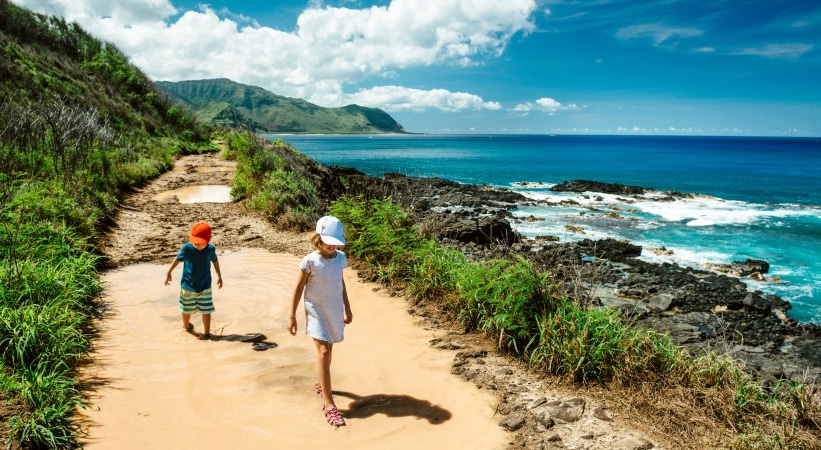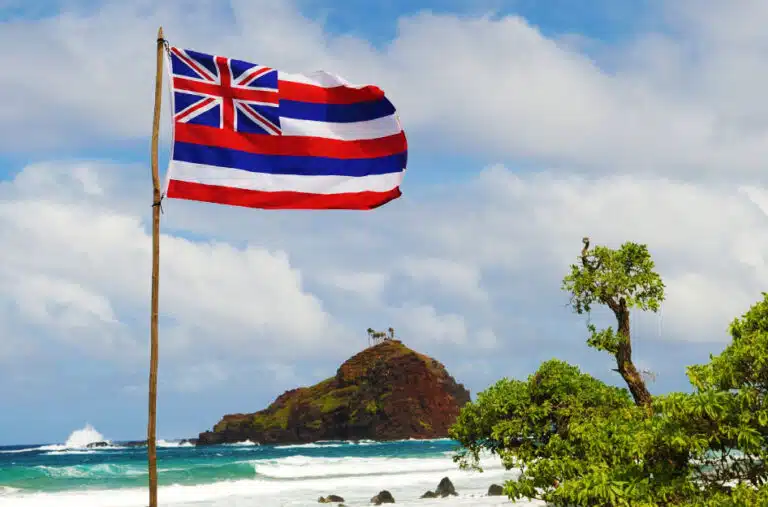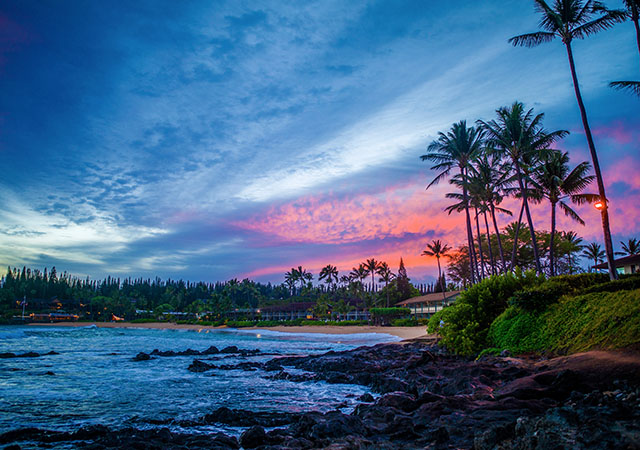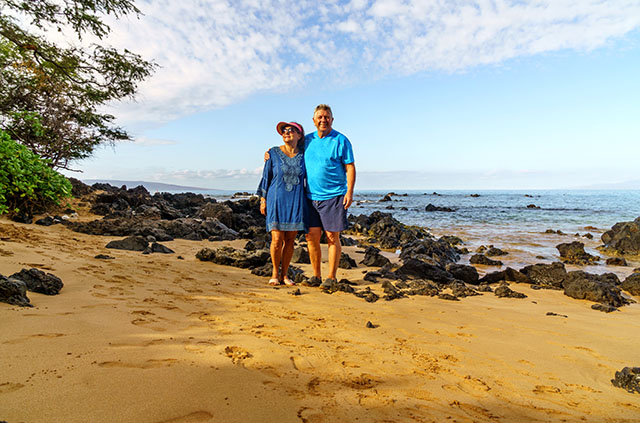Living in Honolulu: Your 2025 Guide to Calling the Hawaii State Capital Home
Hawaii
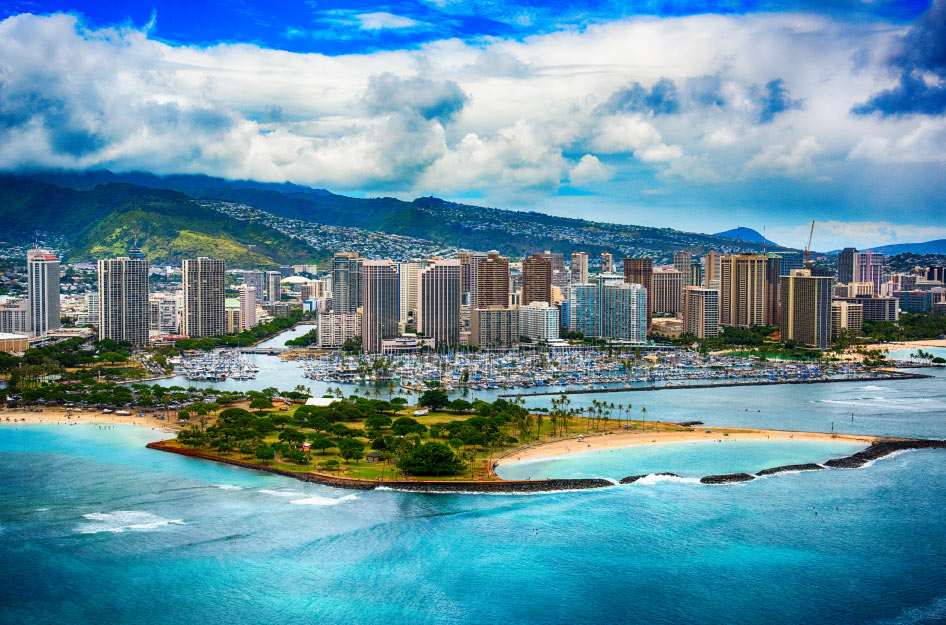
With its warm, sunny weather year-round, Honolulu offers the perfect setting for those who love a tropical climate. World-class beaches like Waikiki and Ala Moana Beach Park are just minutes apart, so you know living in Honolulu means easy access to surfing, swimming, and plenty of fun in the sun. The city is also surrounded by green spaces that make it easy to get outside all year long.
Honolulu is known for its welcoming atmosphere and rich cultural heritage — commonly referred to as the “aloha spirit.” That’s not the only thing you should know before moving there, though.
Honolulu at a Glance
- The city stretches about 10 miles along the shores of Oahu and 4 miles inland across a plain to the Koolau Range foothills.
- It covers a total area of around 597 square miles.
- The population is approximately 337,300.
- The median age is about 43 years old.
15 Things to Know About Living in Honolulu
If you’re moving to Hawaii in search of a beautiful and unique city, Honolulu might seem like the ultimate dream at first, but it’s important to get familiar with all aspects of life to truly determine if it’s the right fit.
The high cost of living is a drawback for some — especially anyone retiring in Hawaii on a fixed income — even with all the living perks. Job opportunities, public transportation, and quality of education are also important factors to consider. To help you make the most well-rounded decision, here’s everything you should know about living in Honolulu.
1. The Cost of Living in Honolulu Falls in Line With Other Major U.S. Metros
Honolulu’s cost of living score falls in line with other major metros around the country, coming in at 171.5 — 71.5 percent above the U.S. average and 3.5 percent above the state average. Overall, the cost of living in Honolulu might not be a sticker shock if you’re moving from somewhere like New York or Los Angeles — where the cost of living scores sit at 172.5 and 161.7, respectively.
| Q: What salary do I need to live in Honolulu? A: A family of four with both adults working needs to make at least $151,555 annually before taxes to cover basic living expenses, while a single person needs to make at least $62,450 annually before taxes. Using the 50/30/20 rule (50 percent needs, 30 percent wants, 20 percent savings), those numbers jump to $303,110 and 124,900, respectively. |
2. The Pros and Cons of Living in Honolulu
Pros of Living in Honolulu:
- Warm weather year round makes it easy to enjoy the unique outdoor beauty of the city.
- Sufficient public transportation allows for smooth commutes and travels.
- The food and shopping scenes are unmatched and one of a kind.
Cons of Living in Honolulu:
- Overall, the high cost of living can make it difficult to live comfortably.
- Extreme weather, including wildfires and tsunamis, can have a serious impact on the area.
- The isolated feel of the city might not be for everyone.
| Q: Is living in Honolulu worth it? A: If you can manage the cost of living and don’t mind the isolated island feel, living in Honolulu can certainly be worth it! |
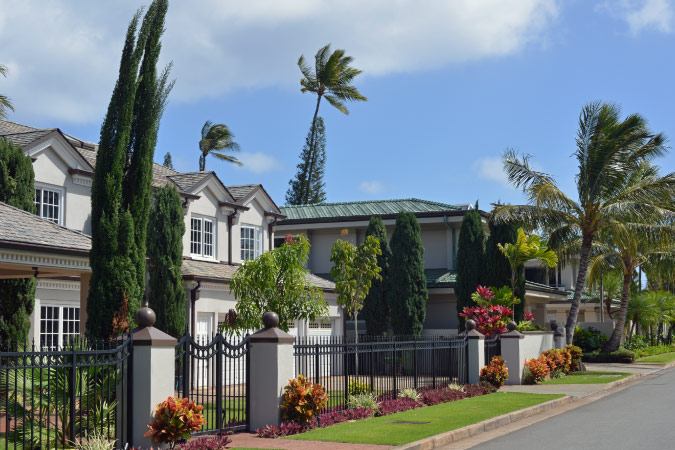
It can be challenging to buy a home in Honolulu due to the inflated real estate prices.
3. Finding a Home in Honolulu
It can be challenging to buy a home in Honolulu due to the inflated real estate prices — the average home price sits at $755,500. When searching for a home in a more desirable neighborhood, the number of properties available for sale is very limited.
Besides some challenges present within Honolulu’s housing market, buying a home here allows you to enjoy a unique lifestyle of beautiful weather, beaches, and outdoor activities right at your fingertips! From traditional to contemporary designs, the homes in Honolulu utilize a variety of natural materials and large lanais to reap the benefits of Hawaii’s climate.
| Q: Can I live in Hawaii on $3,000 a month? A: Living on $3,000 a month in Hawaii can be challenging, but it’s possible with a minimalist lifestyle. You might also need a roommate or two. |
4. A Look at Honolulu’s Rental Market
Renting an apartment versus buying a home in Honolulu is a good way to cut down on some of those housing costs. While rent is heavily inflated throughout various parts of Honolulu — with the average one-bedroom around $2,225 — you can find more affordable prices in certain neighborhoods.
Whether it be a luxury high-rise with an ocean view or a more budget-friendly option in a neighborhood like Kaneohe, apartments in Honolulu can be affordable for all kinds of people, including singles, couples, and families.
| Q: Can I live in Hawaii on $2,000 a month? A: Considering the average rent in Honolulu sits at $2,225, living on $2,000 a month in Hawaii would be very difficult to manage. |
5. Best Places To Live in Honolulu
Whether you’re moving by yourself or bringing the whole family, you’ll need to find the right neighborhood to call home. Take a look at the top neighborhoods in Honolulu and who they’re best suited for.
Mokapu
The friendly community of Mokapu — located near the Marine Corps Base Hawaii — is known for its welcoming atmosphere. And it’s perfect for young professionals and families working on base.
There are a variety of water-based activities available in the area, such as fishing, swimming, and kayaking. The nearby Makapu'u Beach Park is also popular for bodysurfing and bodyboarding, with views of the Lighthouse Trail and Makapu'u Point.
Ala Moana-Kaka'ako
The history of Ala Moana-Kaka'ako is rich with Native Hawaiian culture and entrepreneurship, and it is becoming more urbanized with the development of new buildings and trendy restaurants. This area is ideal for young professionals due to its mix of art galleries, high-rises, and trendy restaurants.
The residents of this area can easily access facilities such as the Ala Moana Center and the Ala Moana Beach Park, which has both green spaces and beaches.
Wahiawa
The neighborhood of Wahiawa is known for its unique location and affordability. Situated near the Ko'olau and Waianae mountain ranges, it offers a climate that's different from other areas. It's also surrounded by a rare reservoir known as Lake Wilson. Compared to other areas in Oahu, particularly those near Honolulu, Wahiawa is much more affordable — perfect for retirees. Single-family houses and larger lots are common in this area.

Honolulu's TheBus is typically considered good, with reasonable rates and extensive routes.
(Source: Honolulu Dept. of Transportation Services via Facebook)
6. Getting Around With Honolulu’s Public Transportation
Honolulu's public transportation system, particularly TheBus, is typically considered good, with reasonable rates and extensive routes. Although it may not be the fastest option, it’s perfect for getting around. Plus, no more worries about parking!
TheBus services are available in lots of areas, including Central Oahu's urban corridor and the Windward and Leeward regions. Fares are reasonable, and it offers day passes, single rides, and multi-day passes through the HOLO card.
Use the bus or transit app to plan your trip and get the best route, but expect some delays, especially during rush hour. Be prepared to sit back and enjoy the area's scenic views during your ride.
7. Honolulu’s Education Faces Challenges, but Shows Promise
Hawaii’s public education system typically ranks towards the bottom — 42 out of 51 states, plus Washington D.C. — when compared to other areas across the U.S. In addition to having lower scores on standardized tests, Hawaii's public schools also struggle when it comes to retaining and recruiting qualified teachers. This can lead to possible instability within the system and the reassignment of teachers.
Despite certain challenges in the education system, the Hawaii Department of Education still has an A- grade on Niche and an 86 percent average graduation rate. Plus, Honolulu has many A-rated schools to choose from.
8. Enjoy Year-Round Warmth With Occasional Weather Risks
Honolulu’s climate is characterized by warm and sunny weather year round. Temperatures range from the 70s to the 80s, and there are minimal seasonal variations. Due to the island's mountains, rainfall on the southwest and leeward portions of the island is significantly less than on the windward side of the mountains.
In addition to tropical cyclones, hurricanes, and high winds, Hawaii can also experience other forms of severe weather, such as tornadic waterspouts. A tornadic waterspout is a type of tornado that develops in the water or over it, which is often associated with thunderstorms and is capable of producing large hail and powerful winds.
9. Lower Than Average Crime Rate Offers Peace of Mind
Honolulu’s crime score sits at an 11, meaning it’s safer than 11 percent of U.S. cities. There is a 1 in 37 chance that one will be a victim of either property or violent crime in this area.
According to NeighborhoodScout, the majority of Honolulu’s crimes are property crimes, and the likelihood of being a victim of these types of crimes in the city is around one in 39.
10. Honolulu Is Showing Steady Growth in the Job Market
Hawaii’s job market has seen some of the most significant improvements compared to all other areas of the U.S. since the pandemic. There’s been a 70.9 percent decrease in the unemployment rate between December 2020 and December 2024. In December 2020, almost 68,200 people were unemployed in the state. By December 2024, the number had decreased to less than 20,000.
In Honolulu, the public sector accounts for around 22 percent of the city's employment — one of the main factors contributing to the overall low unemployment rate and overall stability. Other common industries you’ll find include tourism, agriculture, financial services, and education.
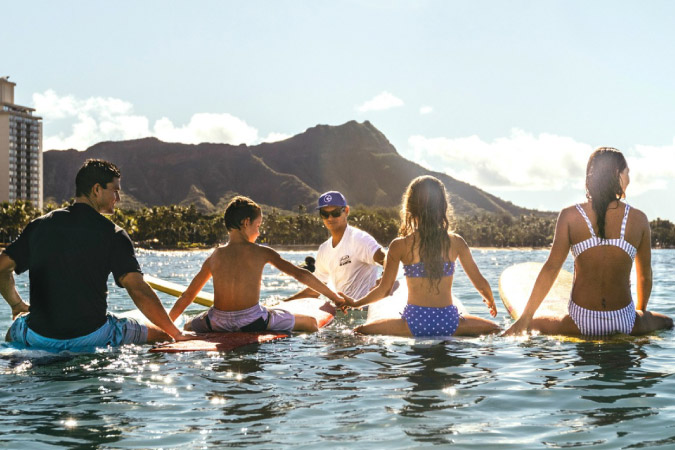
Surfing in Waikiki is a popular pastime for locals and tourists alike.
(Source: Visit Oahu via Facebook)
11. Things To Do in Honolulu
One of the main benefits of living in Honolulu is that there’s always something to do, no matter your interests. The beautiful and abundant city of Honolulu is home to many of Hawaii’s most prominent landmarks. The area's western portion is bordered by Pearl Harbor, and central Honolulu includes popular areas like the world-famous Waikiki Beach. Additional things to do in Honolulu include:
- Honolulu Museum of Art: One of the largest art museums in the state of Hawaii is the Honolulu Museum of Art. You can also visit Shangri-La, which was formerly the home of Doris Duke and features a significant collection of Islamic art.
- Iolani Palace: The Iolani Palace, which was built in 1882, is regarded as one of the most historic royal residences in the U.S. It was the home of the last two monarchs of the Hawaiian Kingdom, King Kalakaua and Queen Lili'uokalani.
- Waikiki: The area known as Waikiki, which is on the southern part of Honolulu's south shore, used to be a playground for royalty. It was first introduced to the world in 1901 when the Moana Surfrider was built. Today, it’s O'ahu's main resort area and is a popular destination for tourists.
- Shopping: Honolulu is a shopper's paradise, with various shopping areas that can accommodate both locals and tourists looking for high-end fashion labels and Hawaiian-made goods. Some of these include the Khala Mall, Ward Centre, and the Aloha Tower Marketplace.
12. O’Ahu Is a Foodie’s Haven
The vibrant dining scene of O'ahu is one of the main benefits of Honolulu. Local celebrity chefs create unique dishes using the freshest ingredients and traditional Hawaiian cooking techniques. They also incorporate influences from other countries, such as the Philippines and Japan.
You’ll find plenty of great fusion restaurants on the island, including The Pig and the Lady, Mud Hen Water, and Lucky Belly.
The North Shore is full of places that focus on fresh seafood. One of those places is the town of Haleiwa, which is known for its surf culture. Food trucks that serve shrimp dishes and poke bowls are also a staple in the area.
13. Take in All of the Flora and Fauna
Hawaii has a wide variety of native flora and fauna. Some of these include the Hawaiian monk seal, which is endangered, as well as various forest birds and marine mammals such as dolphins and whales. There are also over 1,400 vascular plant species in the region, which are not commonly found elsewhere.
Several species of geckos can be found in Honolulu, one of them being the Common House Gecko, which makes distinctive chirping noises at night. It’s the most prevalent gecko in the Hawaiian Islands. They are fascinating creatures to observe due to their unusual agility and speed.
14. Dive Into Endless Water Activities
O'ahu offers endless golden beaches, warm weather, and fun waves year-round. If you're a fan of water activities, like surfing, and want to learn how to hang ten on a board, you can head to Waikiki Beach. You can also explore the ocean with a group canoe trip, or go swimming and snorkeling with the family at one of the beaches.
In addition to water sports, such as surfing, windsurfing, and parasailing, O'ahu also offers other activities, like sailing and sunset cruises. You can spot humpback breaches during the whale watching season, which runs from December to May.

The Chinatown of Honolulu is one of the oldest Chinatown neighborhoods in the U.S.
(Source: Visit Oahu via Facebook)
15. Historic and Cultural Highlights of Honolulu
With a vast history, there’s a lot about Hawaii that you might find fascinating:
- Birthplace of Obama: Barack Obama, the 44th U.S. president, was born in Honolulu and was the first American president to be born in Hawaii. Obama's Hawaiian heritage is a major part of his identity, and this has been a recurring theme throughout his political career.
- Diamond Head: One of the most popular places to visit in Honolulu is Diamond Head, which is a volcanic tuff cone that provides a breathtaking view of the city and Pacific Ocean from its peak. This was formed around 400,000 years ago and has major historical and geological significance.
- Chinatown: The Chinatown of Honolulu, which dates back to the 19th century, is one of the oldest Chinatown neighborhoods in the U.S. known for its various cultural festivals and markets.
Make Your Move to Honolulu an Easy One With PODS
Making your move to Honolulu a flexible one with the help of portable moving containers from PODS — delivered right to your driveway. Need help with the heavy lifting? PODS can connect you with local packing and loading services. Once you're ready, your container will either be picked up and delivered to your new home, or it can be stored in a secure PODS Storage Center. With one month of storage built into the cost of every move, you can take your time getting settled.
Get a free local moving quote online or call 877-350-7637 for long-distance moving.
Editor’s note: For ease of reading, monthly rental prices were rounded to the nearest $25 and home values were rounded to the nearest $100.
*This article was written on behalf of PODS Enterprises, LLC (“PODS”). PODS does not warrant the completeness or accuracy of any information contained in this article and disclaims any liability for reliance upon the content herein.

Your quote in 60 seconds
Get pricing tailored to your needs!

